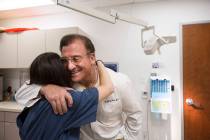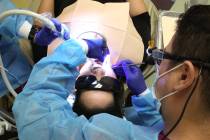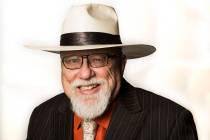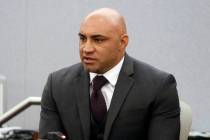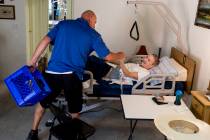Both safety extremes here in our hospitals
Two years ago, Johns Hopkins surgeon Marty Makary penned a Wall Street Journal piece, “How to Stop Hospitals from Killing Us,” which contained a paragraph that was at once sickening and a call to action.
“Medical mistakes kill enough people each week to fill four jumbo jets. But these mistakes go largely unnoticed … and the medical community rarely learns from them. The same preventable mistakes are made over and over again, and patients are left in the dark about which hospitals have significantly better (or worse) safety records than their peers.”
Change, mercifully, was already underway — and it was demonstrated again last week when the Leapfrog Group issued its latest national report card on hospital patient safety. In it, Las Vegas’ medical community received the lowest and highest of grades. (The full report is at www.hospitalsafetyscore.org.)
The hospital patient safety movement’s roots trace back to the 1990s, when the Institute of Medicine estimated as many as 100,000 Americans die annually because of preventable medical errors in the nation’s hospitals.
Now, thanks to hospital surveys from organizations that include Leapfrog, Consumer Reports, HealthInsight, Healthgrades and the federal government’s Hospital Compare, medical consumers are afforded much more opportunity to learn how hospitals work, or don’t work. And we can make more informed choices about where we want to go for care.
To say hospital administrators haven’t appreciated the call for transparency is an understatement. But it appears they are also finally learning from the surveys. Jackson Park Hospital and Medical Center, for instance, a financially strapped facility on Chicago’s tough south side where approximately 80 percent of the patients are on Medicare and Medicaid, went from a Leapfrog grade of F in 2012 to an A in 2014.
No one in Las Vegas, of course, can be happy that taxpayer-supported University Medical Center was one of 22 hospitals nationwide to receive an F from Leapfrog. Unfortunately, that failure was only compounded by the response to it by new UMC CEO Lawrence Barnard, who complained about the evaluation’s fairness, arguing UMC doesn’t “pay to play.”
This was on top of the hospital’s chief medical officer, Dr. Joan Brookhyser, claiming that UMC didn’t voluntarily participate in the survey because a full-time staffer would have had to have been hired to fulfill Leapfrog’s documentation demands. The Las Vegas Review-Journal could not find anyone at another hospital who said the time demands were that high.
Sam Kaufman, under whose leadership Desert Springs Hospital rose from a B to an A in the Leapfrog survey, said the documentation is simply picked up by a hospital quality control administrator who must compile similar figures for several entities, including the federal government.
Instead of complaining about Leapfrog’s test — Brookhyser and Barnard knew what was on it so they couldn’t moan “there were too many trick questions” — the pair should have assured the public the pitiful performance wouldn’t be repeated.
UMC staff knew, just as the staff did at Desert Springs and at the other local hospital to receive an A, St. Rose Dominican Hospital — Rose de Lima, that a patient was supposed to receive an antibiotic within one hour before surgery.
Yet UMC’s score of 89, was below the national mean of 98.64, while Desert Springs had a 100 and St. Rose de Lima 99.
When it came to ensuring that patients received the right antibiotic, St. Rose de Lima scored 100, Desert Springs 99 and UMC 97, again below the national mean.
Did UMC score low in these areas of providing antibiotics because the Leapfrog survey was unfair? No. The vast majority of information used in the Leapfrog evaluation is the same that all hospitals give to the federal government.
Again and again on the survey, far too many of UMC’s poor results make you want to roar: “If all else fails, try following directions.” If that’s done, UMC can receive an A as Jackson Park Hospital and Medical Center did and as Detroit Receiving Hospital did — where, like UMC, most of its patients are on government assistance.
Dr. Jerry Reeves, a vice president of HealthInsight, believes UMC has plenty of stars — its surgeons are so top-notch they’d be the ones operating on the president should he be hurt here — but the supporting cast isn’t on the same page.
“You can’t have all quarterbacks and no tacklers and blockers,” he said. “I don’t know if there isn’t a care plan or it’s not communicated to the rest of the team, but everyone just seems to be winging it.”
UMC, he said, needs leaders who inspire other people to follow.
When I think of such a person at UMC, the name Meena Vohra always comes to mind. She’s the pediatrics chief whose intensive care unit follows infection control policies so closely that it was one of only five such units nationwide in 2012 to experience zero central line bloodstream infections, better than the Mayo Clinic or St. Jude Children’s Research Hospital.
Not long ago, nurse Abby Hudema recalled how Vohra walked out of a tiny patient’s room with dark circles under her eyes — “she had been at bedside all night to keep the child alive.” But in an upbeat way, she was still always asking questions about why this had or hadn’t been done.
Hudema said she believes Vohra’s passionate commitment to patients’ welfare, including her vigilance in hand washing and always wearing gloves, gown and mask when inserting a central-line catheter, has created an attention-to-detail medical staff.
“The way I look at it,” Vohra told me, “if the leader follows the rules, everybody does. You have a domino effect.”
Contact reporter Paul Harasim at pharasim@reviewjournal.com or 702-387-2908.








